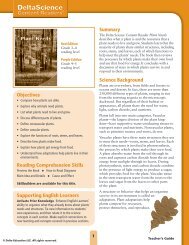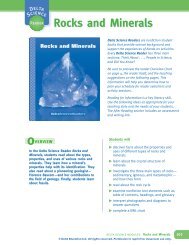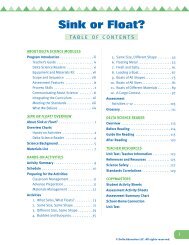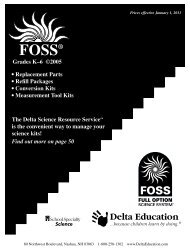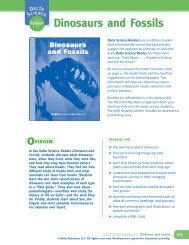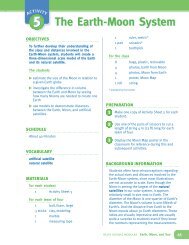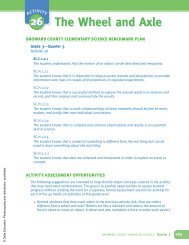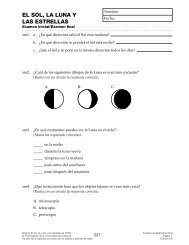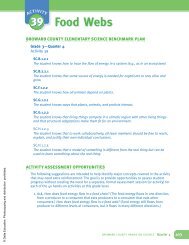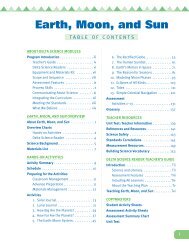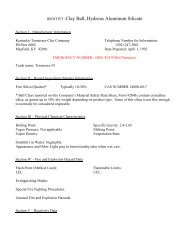Create successful ePaper yourself
Turn your PDF publications into a flip-book with our unique Google optimized e-Paper software.
<strong>Earth</strong> <strong>Processes</strong>CONTENTSThink About . . .What Is Inside <strong>Earth</strong>? . . . . . . . . . . . . . . . . . . . . . . . . . . . . . . 2How Has <strong>Earth</strong>’s Surface Changed Over Time? . . . . . . . . . . . 4Theory of Continental DriftPlate TectonicsSea-Floor SpreadingPlate Movements . . . . . . . . . . . . . . . . . . . . . . . . . . . . . . . . . 7Plate BoundariesStresses and Faults<strong>Earth</strong>quakesVolcanoesWeathering, Erosion, and Deposition . . . . . . . . . . . . . . . . 11WaterLiving ThingsIce and GlaciersWindGravityHow Do Rocks and Soil Form? . . . . . . . . . . . . . . . . . . . . . . 16Rock FormationThe Rock CycleSoil FormationConserving SoilPeople in ScienceHarry Hess . . . . . . . . . . . . . . . . . . . . . . . . . . . . . . . . . . . . . . 21Did You Know?About Geologic Time . . . . . . . . . . . . . . . . . . . . . . . . . . . . . 22Glossary . . . . . . . . . . . . . . . . . . . . . . . . . . . . . . . . . . . . . . . 231
GlossaryA page number in boldface type indicates the page onwhich the word is defined in the text.abrasion gradual wearing off of small fragments of rockby windblown sand, moving water, or glacial ice (14)absolute age actual age of a rock or fossil (22)asthenosphere hot layer of <strong>Earth</strong>’s upper mantle thatflows very slowly (5)cementation process that forms sedimentary rock whenlarge sediments are “glued” together by minerals depositedbetween them (17, 18)chemical rock type of sedimentary rock that formswhen water evaporates and leaves behind layers ofminerals (18)chemical weathering breaking down of rocks bychanging their chemical composition (19)clastic rock most common type of sedimentary rock,made of smaller pieces of other rocks (17)climate weather pattern in a particular area over a longperiod of time (19, 22)compaction process that forms sedimentary rock whenlayers of small sediment are compressed by the weight ofthe layers above them (17, 18)conduction transfer of heat energy through solid matteras one particle strikes another (3)continent large land mass (2, 4, 5, 7)continental drift idea that continents move from onepart of <strong>Earth</strong> to another (4–6, 21)continental glacier thick sheet of ice that covers a largeland area (14)contour plowing plowing crop rows across a hill toprevent erosion (20)convection transfer of heat energy from one place toanother by flowing matter (3)convection current cycling of flowing matter as it isheated and then cooled, due to density differences (3, 5)convergent boundary place where two plates collide (7)core center part of <strong>Earth</strong> (2, 3)creep mass movement in which sediments move slowlydown a hill (15)crust <strong>Earth</strong>’s outermost layer (2, 3, 5–11, 18, 21)deflation wind erosion that removes small, loosesediment but leaves behind large materials (14)deformation bending and stretching of rocks (8)deposition dropping of eroded sediment in a new place(11–13, 15)divergent boundary place where two plates are movingapart (7)dome mountain mountain that forms when a pocket ofmagma pushes up against the layers of crust above it,forming a dome shape (10)drainage basin area that is drained by a river and itstributaries (11)dune mound of loose sand deposited by wind (15)Dust Bowl area in the central United States that sufferedsevere drought during the 1930s, causing huge duststorms (20)earthquake vibration of the ground caused by suddenmovements along faults that occur when rocks breakunder stress and release energy (2, 7, 9, 15, 21)epicenter point on <strong>Earth</strong>’s surface directly above anearthquake’s focus (9)erosion movement of sediments from one place toanother (11, 12–15, 17–18, 20)extrusive formed when lava cools above <strong>Earth</strong>’s surface(16)fault crack in <strong>Earth</strong>’s crust along which rocks move (8, 9)fault-block mountain mountain that forms along anormal fault where stress causes huge blocks of rock totilt up (8)focus point in <strong>Earth</strong>’s interior where earthquake energyis released (9)folded mountain mountain formed when rock layersare squeezed from opposite sides, causing them to buckleand fold (8)fossil preserved remains, imprints, or traces of anorganism (4, 22)geologic time scale record of geologic events and livingthings in <strong>Earth</strong>’s history (22)geologist scientist who studies <strong>Earth</strong> (2, 6, 22)geyser hot spring that periodically shoots groundwaterand steam up into the air (10, 13)glacier huge mass of moving ice (14, 15)gravity force that causes materials to move downward(13–15, 18)groundwater fresh water that is stored in the ground(10, 12, 13, 15)hot spot area in <strong>Earth</strong>’s mantle that is hotter thansurrounding areas, forming melted rock that rises towardthe crust (10)hot spring natural spring where heated groundwaterflows from the ground (10, 13)humus once-living, decayed material found in soil (19,20)ice wedging breaking of rocks when water in cracksfreezes and expands (14, 19)igneous rock rock formed from cooled magma (16–18)index fossil fossil of a living thing that was abundantand widespread for a short period of geologic time, used todate rock layers in which it is found (22)inner core solid iron center of <strong>Earth</strong>’s core (3)intrusive formed when magma cools and hardensbeneath <strong>Earth</strong>’s surface (16)lava magma that reaches <strong>Earth</strong>’s surface (2, 10, 16)lithosphere brittle outer layer of <strong>Earth</strong> that includes thecrust and top part of the upper mantle (5, 8)loam soil that has a good mix of sand, silt, clay, andhumus (19)23
loess thick layer of fine sediment deposited by wind (14)magma melted rock formed inside <strong>Earth</strong> (6, 7, 10, 16, 18)magnitude measure of the energy released by an earthquake(9)mantle layer of <strong>Earth</strong> between the crust and outer core(2, 3, 5, 6, 9, 10, 18, 21)mass movement erosion in which gravity causes loosematerials to move downhill (15)mechanical weathering process that breaks downrocks without changing what they are made of (19)metamorphic rock rock formed from other rock byheat and pressure (17, 18)mid-ocean ridge long, narrow chain of underwatermountains (6, 7, 10, 21)mineral nonliving, solid material found on or in <strong>Earth</strong>;building block of rock (13, 16–19)moraine ridge of materials left behind when a glacierstops moving forward (14)normal fault tension fracture in rocks where rock onone side drops down relative to the other side (8)organic rock type of sedimentary rock made from theremains of once-living things (18)outer core liquid metal layer of <strong>Earth</strong> between the innercore and mantle (3)Pangaea name of the huge continent that broke up intotoday’s land masses (4, 22)permeable allowing water to pass through (12)plate one of the blocks of crust and upper mantle thatmake up the lithosphere (5–8, 10, 18)plate tectonics theory that <strong>Earth</strong>’s solid plates move ontop of the asthenosphere (5, 18, 21)plateau flat, broad, raised area of land (8)relative age age of one rock layer compared to another(22)reverse fault break in the crust where rock on one side ispushed up relative to the other side (8)rift deep valley that runs along the crest of the mid-oceanridge (6)rock natural solid that is usually a mixture of minerals(2–4, 6, 8–16, 17–22)rock cycle slow but constant formation and destructionof rocks and rock materials (18, 19)runoff rainwater or melting snow that drains off landinto streams (11, 12)sea-floor spreading process by which new oceanic crustforms at the mid-ocean ridge, spreads away from the ridge,and is subducted into the mantle at trenches (6, 21)sediment loose material composed of bits of weatheredrock (11–15, 17, 18)sedimentary rock rock formed when layers of sedimentare compacted or cemented together (17, 18)seismic waves energy waves that move outward from anearthquake’s focus and make the ground shake (9)seismograph instrument used to record earthquakewaves (9)slump mass movement in which one large mass of loosematerial or rock layers moves downhill (15)soil mixture of weathered rock, decayed organic materials,mineral bits, water, and air (2, 12–15, 19, 20)soil conservation protection and wise use of soil (20)soil horizon layer of soil (20)soil profile cutaway view showing different soil horizons(20)sonar instrument used to determine the depth of waterby the reflection of sound waves off the sea floor (6, 21)stress force that acts on tectonic plates (8, 9)strike-slip fault break in the crust where two blocks ofrock scrape along each other in opposite directions (8)strip cropping planting different kinds of crops side byside in strips to help prevent soil erosion (20)subduction process in which the edge of one plate sinksbelow the edge of another plate (6, 7, 10)till mixture of boulders, stones, and sediment depositedby a melting glacier (14)transform boundary place where plates meet and slidepast each other (8)trench deep, narrow ocean canyon that forms where oneplate is subducted under another (6, 7, 21)tsunami seismic sea wave caused by an underwaterearthquake; grows in height as it approaches land (9)valley glacier river of ice that moves downhill slowly(14)vent opening in <strong>Earth</strong>’s surface through which lava canflow (10)volcanic neck landform created when magma cools andhardens inside a volcano’s vent and is later exposed whenthe volcano’s cone wears away (10)volcano mountain that forms around a vent wheremagma escapes to <strong>Earth</strong>’s surface (2, 10, 15, 16)water table upper surface of the zone of saturation (12,13)weathering breaking of rocks into smaller pieces bywater, temperature changes, wind, or living things (11,12, 14, 15, 17–19)zone of saturation zone of rock and soil in which allavailable space is filled with groundwater (12, 13)24



